Top News
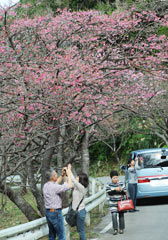
January 20, 2012 Ryukyu Shimpo
Taiwan cherries have begun blooming and attracting people to see them at Mt. Yaedake, Motobu. The Motobu Yaedake Cherry Blossom Festival started on January 21 with the catchphrase of “One jump ahead.”
On January 19, the temperature in Ishigaki island reached a record high for that month of 25 degrees celsius. Kenji Takeuchi, who was visiting Okinawa with friends from Tokyo said, “The pale pink blossoms have a glamorous air to them.” He took some photographs of the beautiful scene under a clear blue sky.
January 21 is Daikan, traditionally the coldest day of the old solar calendar.
According to the Okinawa Meteorological Agency temperatures in Okinawa will be around the same as previous years.
(English translation by T&CT, Shinako Oyakawa and Mark Ealey)
Go To Japanese

Go To Video
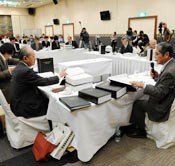
January 20, 2012 Ryukyu Shimpo
On January 19, the Okinawa Prefectural Board of Review for the environmental impact assessment report (EIA) for the alternative facility construction plan of the U.S. Marine Corps Air Station Futenma in Henoko, Nago, convened in Nishihara. At the beginning of the meeting, Board Chairman Kuniharu Miyagi, professor at Okinawa International University, expressed his strong dissatisfaction that Okinawa Defense Bureau officials had delivered the EIA to the Okinawa Prefectural Government (OPG) Office before dawn at the end of last year. Members of the board raised questions about the plan to deploy MV-22 Osprey vertical takeoff and landing transport aircraft being included for the first time in the evaluation report at the final stage of the assessment process. On almost all of the matters covered, members called for projections and assessments to be redone. About 120 people, including members of the public, sat in on the meeting, which was also attended by nine professors of universities in Okinawa.
It was pointed out that the reasoning is unclear as to why the shape of the flight path has been changed from trapezoidal to elliptical, taking aircraft closer to residential areas, and why the impact assessment of low-frequency sound and noise on the surrounding areas due to the irregular flight path has not been included. Many other issues were raised, such as the fact that there is no impact assessment of the tidal changes that would be caused by large-scale reclamation of 160 hectares of land and the effect that those changes would have on the surrounding natural environment nearby Oura Bay and Oura River. Members of the board suggested that the governor should clearly point out such issues in his statement of opinion on the EIA.
The OPG plans that the next meeting of the board will include an opportunity to hear the views of residents, because the governor is able to incorporate a wide range of people’s opinions in his statement. The OPG Department of Environmental and Community Affairs will accept written comments from residents, and details will be provided on the OPG’s website as soon as they are decided.
The meetings are held to discuss concerns regarding the airport construction project based on the Okinawa Prefecture Environmental Impact Assessment Ordinance, but there is no provision on the same ordinance to require the board to meet and review the reclamation plan. Chairman Miyagi said, “The two projects of the airport and the landfill are inextricably linked.” Board members confirmed that their remarks on the landfill project should be also included as additional opinions.
The next meeting will be held on January 27, but the time and venue are yet to be decided. The members of the board will report their findings to the Governor of Okinawa at the beginning of February. Governor Hirokazu Nakaima is then required to submit a written statement of opinion to the Ministry of Defense by February 20.
(English translation by T&CT, Mark Ealey)
Go To Japanese
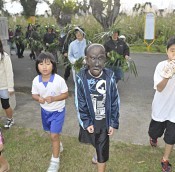
January 18, 2012 Ryukyu Shimpo
On January 17 at Uenonobaru in Miyakojima, a traditional ritual called satiparo was held. With children wearing masks and performing as a visiting deity pantu in the lead, wrapped in vines, women carrying yabunikkei twigs in their hands walked around the community and drove away evil spirits. The satiparo ritual was designated as a significant intangible folk cultural asset in 1993. The event is held on the last day of the ox of every December of the old calendar. Adult males don’t take part, but females and children do.
At around 5:30pm, women and children gathered at an old well and departed at approximately 6:00pm. Calling out “hoi, hoi,” the women beat the bundles of yabunikkei together and walked through the community. At intersections, they surrounded children and exorcised evil from them.
A fifth-grade pupil at Ueno Elementary School, Yota Kudaka, who performed pantu for the first time said, “It was fun to parade wearing the mask.” Junko Shimajiri said, “I was relieved when it was over. I hope that I can take part again in future.”
(English translation by T&CT, Lima Tokumori and Mark Ealey)
Go To Japanese
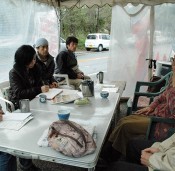
January 16, 2012 Ryukyu Shimpo
On January 15, Daisuke Shirane, member of the International Movement Against All Forms of Discrimination and Racism (IMADR), an international non-governmental organization devoted to eliminating discrimination through United Nations agencies, visited the planned relocation area for the Futenma Air Station, Henoko in Nago, and the planned new helipad construction area at Takae in Higashi Village. Shirane also met residents opposed to the construction of the U.S. military base.
IMADR is a United Nations authorized NGO that holds consultative status. From January 14, Shirane visited both Futenma and Kadena air bases and participated in a study group with a non-governmental organization, the Association of Indigenous Peoples in the Ryukyus.
At Takae, Shirane suggested to local residents that they take advantage of the early-warning measures and emergency procedures at the UN Committee on the Elimination of Racial Discrimination to be held in February. These procedures require the government of the country where the problem exists to provide information. In some cases, the Committee recommends that the situation be rectified. Although such a recommendation is not legally binding, it would send a strong message to the Japanese government and to the international community.
Shirane stressed that the Universal Periodic Review, which reviews human rights situation of all countries, will focus on Japan in October, so lobbying from Okinawa will be very important. A recommendation from any of the treaty agencies concerned with likes of children’s or women’s rights would have great impact. Regarding the U.S. military bases in Okinawa he stated, “I never understood the full extent of the burden on local residents until I actually saw it for myself. The situation in which there is no jurisdiction over U.S. military related accidents and crimes is unfair and abnormal on an international level. This should by given more attention by the United Nations.”
(English translation by T&CT, Megumi Chibana and Mark Ealey)
Go To Japanese
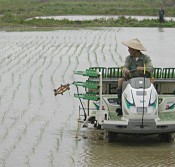
January 17, 2012 Ryukyu Shimpo
On January 15, the planting of rice commenced on Ishigaki Island, which is known as the top rice producing area in Okinawa. This is the earliest planting of rice anywhere in Japan. Atsushi Nakaarashiro a 75 year-old rice grower who produces koshihikari began planting at a place called Hiratabaru, the only paddy field area in Ishigaki. This year’s planting commenced a week or so later than usual due to the slow growth of seedlings because of the lack of sunshine since last November. Harvest is scheduled to occur in mid-May.
Nakaarashiro said, “We do our best to look after our paddy fields. We would like to bring rice to consumers that they can eat without any concerns.”
(English translation by T&CT, Mark Ealey)
Go To Japanese

January 17, 2012 Takesaburo Koyama correspondent of Ryukyu Shimpo
From January 6 to 10 at Akama Sports Park in Onna, 41 players for the Korean Olympic football squad went into a camp at which they made their final adjustments ahead of the Olympic Asian qualifying tournament. On January 6, a welcome ceremony was held on the Sports Park’s football field, in which officials of Onna Village, and other local people, presented the players with local products such as tankan oranges.
In his speech, Deputy Mayor Shuko Ikemiyagi said, “Last year, the Korean professional baseball team the Samsung Lions held a camp in Onna and they went on to win the Asian Games. I look forward to the football results too.” Choboku Ie, the head of the Okinawa Football Association, encouraged them, saying, “Aim to win the regional title. Japan certainly wants to do so! Let’s meet in London.”
Deputy Mayor Ikemiyagi, General Manager of the Okinawa Convention & Visitors Bureau Jinshun Uchima and Deputy Manager of the Rizzan Sea-Park Hotel Tancha-Bay Kose Matayoshi gave the players some gifts of local products. The Korean team director, Hong Myung-Bo, thanked them and said, “We will do our utmost to be able to participate in the Olympic Games.”
(English translation by T&CT, Lima Tokumori and Mark Ealey)
Go To Japanese
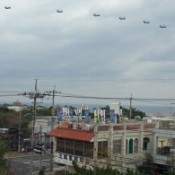
January 14, 2012 Ryukyu Shimpo
On January 12, it was confirmed that six CH 46 helicopters that operate out of the United States Marine Corps Air Station Futenma flew in formation over an area of Ginowan City adjacent to the base. These helicopters are rarely known to fly in formation. The Ginowan Municipal Office received five complaints from local residents about the noise generated by the helicopters.
According to the Municipal Office, it was confirmed that the helicopters flew around the city twice that day, first at around 9:50am and then at around 12:25pm, repeatedly taking off and landing. Among the complaints received by the Municipal Office Military Base Liaison Section, some of local residents stated, “The helicopters flew over residential areas, causing disruption in our lives. We request that the U.S. military change this flight path immediately.”
(English translation by T&CT, Mark Ealey)
Go To Japanese
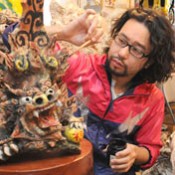
January 17, 2012 Kiyoshi Ujiie of Ryukyu Shimpo
In attempt to offer encouragement to the people of Fukushima, who are worried about radioactivity from the nuclear accident following the Great East Japan Earthquake, 35 year-old shisa craftsman from Naha, Mitsuo Miyagi crafts shisa holding a ball with the inscription of “fuku,” which means good luck in Japanese. He is giving one such shisa to the Gallery Kan in Koriyama City, Fukushima Prefecture and his Okinawan Shisa Exhibition will be held there from January 20. He said, “All I can do to help is to make shisa. Now is the time for the guardian shisa to go to work.”
Miyagi’s shisa are made from waste tiles and plaster from tile factories and demolition sites of old houses. “I love creating gods out of things that would otherwise be thrown away! There is nothing in the world that can’t somehow be used,” said Miyagi. He links the idea of shisa made from recycled materials with that of the reconstruction of the disaster affected areas in Fukushima.
Not long after the earthquake, hearing that there was a food shortage in the areas affected by the disaster, Miyagi packed goya and shima rakkyo in a box and sent it to his old friend Kazuhiro Sato of Gallery Kan.
Last summer, Sato then thought of using the power of shisa that drives off evil spirits and brings luck to try to help cheer up the people of Fukushima with, so he asked Miyagi if he could hold a shisa exhibition. Having thought about other ways of supporting the disaster-stuck area besides sending supplies, Miyagi gladly consented to his friend’s request. More than 100 large and small shisa, including many new works, will be displayed at the exhibition. The shisas’ faces look upward, hoping to inspire the people of Fukushima to be positive. Miyagi says, “Okinawa has recovered well since the Battle of Okinawa. It’s really tough for Fukushima now, but things will eventually get better.” The exhibition will run until January 30.
(English translation by T&CT, Megumi Chibana and Mark Ealey)
Go To Japanese
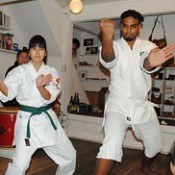
January 10, 2011 Ryukyu Shimpo
Sherus Hiwat from the Republic of Suriname in South America, who is traveling to learn five countries’ martial arts including Korean taekwondo, Muay Thai of Thailand and Chinese kung fu, came to Okinawa at the end of last September to study karate where it originated. Hiwatt said, “I understand that here in Okinawa karate is deeply ingrained in people’s lives. I will be able to experience the essence of karate by learning it here in Okinawa.” He is busy practicing under the tutelage of Kounanryu grand-master Fujiyoshi Kinjo at the Tsuboya Children’s Center in Naha.
Hiwat has been interested in martial arts since he was child, and he attended a boxing gym in Suriname when he was in his teens. He was dedicated to his practice, but there were no trainers capable of explaining the logic behind certain movements, or why they needed to do certain types of practice.
When he went to Mexico, which has a much longer history than Suriname in the sport of boxing, he asked a boxer about these things, and gained a better understanding of the meaning of footwork. “If I don’t learn a martial art closer to where it actually originated, I will never be able to master it in its pure form.” Then he decided to visit the places or origin of the martial arts that were of particular interest to him.
Studying karate in Okinawa for one year, he sets off on his ten-year plan to learn aiki jujutsu of Osaka, taekwondo, Muay Thai, kung fu and the traditional martial art from India called kalaripayattu.
After coming to Okinawa in September last year, Hiwat looked for a karate master in the southern part of the main island. At an event, he saw the karate performance of Yoneko Akamine, a resident of Tsuboya in Naha who has studied kounanryu and he talked to her about his plans. Since then he has practiced under the tutelage of Akamine’s mentor, Grand-Master Fujiyoshi Kinjo.
When he is not practicing, he helps to sell eggs at a store run by Akamine in Shintenchi-Ichiba Hondori in Makishi, Naha. He is called Keeba by the local children because he wears a necklace made of animal teeth, or kiba in Japanese.
“I’m living far away from my family and friends, so it is difficult at times, but I am determined to learn the essence of martial arts,” said Hiwat said.
(English translation by T&CT, Lima Tokumori and Mark Ealey)
Go To Japanese
January 14, 2012 Ryukyu Shimpo
On January 13, the Performance Corps FEC and C-POPTV commenced a dedicated channel on acTVila, a content-on-demand service, on which they began to distribute the Funny tales about U.S. military bases in Okinawa Part VI. FEC is going to distribute its regular performances, including the series Funny tales about U.S. military bases in Okinawa on the web-based on-demand service. FEC is based in Naha, and its counterpart, Tokyo based Video and Film Distributor C-POPTV, has an office in Chatan.
The acTVila service provides video on-demand for digital television using broadband. Panasonic, Sony, Sharp and other major companies have invested in the company. Currently, 3.47 million television sets are compatible with acTVila and FEC has started a video delivery service. Customers can choose one of two services – a 210 yen one-pack for three days or a pack including everything for seven days, which costs 504 yen.
A spokesperson for C-POPTV said, “In recent years, a new approach has started to take hold by which people who enjoy watching videos and films use the on-demand delivery service directly to their home TVs, rather than from rental video shops. We would like to provide more opportunities for people who live outside of the prefecture to watch FEC’s live performances.”
(English translation by T&CT, Mark Ealey)
Go To Japanese

January 12, 2012 Ryukyu Shimpo
With the harvest season of sugarcane having started, on January 11, four sugar factories in Okinawa have started to haul in sugarcane for processing. This last year, because of the low temperatures at the beginning of spring, insufficient sunshine hours, frequent damage from typhoons and little rain during the germination period, all areas of Okinawa are expected to produce a poor crop, and the annual output of sugarcane will decrease as a result. According to the Japan Centrifugal Sugar Industry Association, the annual output of sugar raw material is 583415 tons, a decline of 22.9 percent from the same period the previous year, and the annual output of sugar produced is 69550 tons, down 21.2 percent from the previous season, the lowest since Okinawa’s reversion to Japanese administration.
Shonan Seito Co., Ltd., based in Tomishiro, which handles sugarcane from areas south of Kitanakagusuku, held a ceremony to mark the raw materials coming to the factory. President Genyu Nakazato said, “Bad weather has negatively affected output, but I hope that we can make sugar with zero waste.” In the current season, it is expected that the output of sugar material will be 90000 tons, a decline of 23.6 percent from the previous year, and that sugar production will be 10782 tons, down 24.3 percent from the previous season.
In Miyakojima, the largest producer of sugarcane in the prefecture of Okinawa, each sugar mill also held a season starting ceremony and workers prayed that there be no accidents or disasters this season.
Okinawa Sugar Manufacturing Co., Ltd., in Shimoji, Miyakojima, expects that the annual output of sugar material will be 98000 tons, down 28.2 percent from the previous term, and sugar production will be 12054 tons, a decline of 26.6 percent from the previous season. Factory Manager Genyu Sunagawa stated, “This last year we have faced some very testing weather conditions, but thanks to farmers’ good work we have been able to achieve some levels of production. We are very grateful for this.”
Miyako Seito Co., Ltd., began to operate two mills at Gusukube and Irabu. It is expected that combined output of sugar material from both mills will be 13536 tons, a decline of 20.3 percent from the previous term, and that sugar production will be 16461 tons, down 16.2 percent on the previous season.
This season’s sugar manufacturing in Okinawa starts at Ishigakijima Sugar Manufacturing Co., Ltd., on January 7, with ten factories run by nine companies coming into operation in the period through until March or April. There was a great deal of rain since last November, so the sugar production output may be down even lower than has been announced.
For similar reasons, the annual output of sugarcane for brown sugar also is expected to be down.
(English translation by T&CT, Lima Tokumori and Mark Ealey)
Go To Japanese











 Webcam(Kokusai Street)
Webcam(Kokusai Street)


